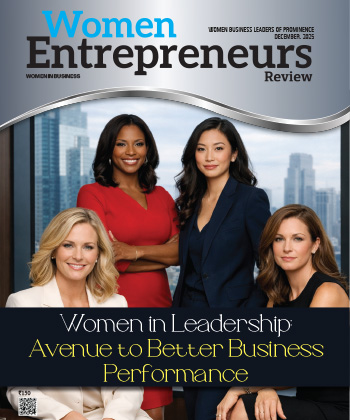
Navigating the Future of Retail with Integration of Technology
By: Arpita Ghosh, AVP, Landmark Group
Arpita Ghosh is a seasoned architect with 18 years of experience specializing in retail and commercial design. She currently leads the Store Design and Space Planning team for Max Fashion and Easybuy brands at Landmark Group, overseeing the design and execution of retail stores nationwide in India. Arpita's leadership approach is inclusive, emphasizing empowerment to drive results within her teams.
In a recent conversation with Women Entrepreneurs Review Magazine, Arpita discusses technology's impact on retail, emphasizing key trends and strategies to navigate consumer demands for speed, sustainability, flexibility, and profitability while enhancing in-store experiences through IoT and advanced tech.
Could you share some insights from your extensive experience in the construction and retail industry, particularly regarding leadership strategies that have proven effective in the field of retail?
The world of retail is ever-evolving, and one of the key drivers of change is the dynamic landscape of retail design. Hence, Resilience and Adaptability is the key leadership strategy one must follow in the retail industry. Adapting multiple business expectations on store layouts and facades, handling difference of opinions wrt design, as design is relative subject and taking right decisions irrespective of job positions is an important aspect of leadership.
Secondly, having a founder’s mentality as a leadership practice. "Founder's mentality" is the kind of growth-driven attitude we see in people who have established successful and is characterized by a passionate belief in your product, a clear and shared sense of purpose among teams. When leaders lose sight of these fundamental strengths, success can slip away.
The retail industry has experienced significant disruption in the last few years, largely owing to the rapid evolution of technology. In your opinion how has technology disrupted the retail as a whole? Are there any specific tech trends that you are betting on?
In the 21st century, technology has become an integral part of our daily lives, and its impact on retail design is undeniable. Retailers are leveraging cutting-edge technologies to enhance the in-store experience. Interactive displays, augmented reality (AR), and virtual reality (VR) have found their way into retail spaces, providing customers with immersive and engaging experiences. For example, some stores now employ AR mirrors that allow customers to virtually try on clothing items, revolutionising the traditional fitting room experience.
The advent of generative AI (gen AI) marks a transformative era. How can retail businesses effectively discern, adopt, and scale the utilization of Generation AI technology to revolutionize their operations and grasp its industry-wide implications?
AI has been and will continue to be the most significant disruptor in retail since the advent of online shopping. Retailers will use generative AI to help improve the pre-purchase shopping experience, enabling more sophisticated chatbots in online environments to aid with service requests and create better efficiencies throughout the organization regarding content creation. AI technologies and solutions will drive innovation faster, improve the shopper journey, deepen loyalty, and elevate the overall brand. Retailers have already jumped into using AI to foster more profound levels of personalization in marketing efforts. Micro-segmentation and building robust communities are two ways marketers build brand assets to grow customer loyalty. Brands are figuring out how to deliver hyper-personalization in a relevant and non-intrusive way.
The integration of smart technologies within physical stores is creating a more interactive and personalized shopping experience. How are smart stores leveraging IoT devices and advanced technologies to enhance the traditional brick-and-mortar shopping experience for customers?
The rise of e-commerce has prompted retailers to bridge the gap between physical and online stores. The concept of an omnichannel approach has gained momentum, where customers can seamlessly transition between online and offline channels. Retailers are incorporating technologies like QR codes and mobile apps to enable customers to scan products in-store, access additional information, and even make purchases for home delivery. This trend aims to create a cohesive shopping experience, regardless of the channel customers choose.
How can retail leaders navigate the shifting consumer priorities towards speed and sustainability, while addressing employee needs for flexibility and delivering profitable growth to shareholders?
In an era where environmental consciousness is on the rise, sustainability has become a central theme in retail design. Consumers are increasingly mindful of the environmental impact of their purchases, prompting retailers to adopt eco-friendly practices in their designs. Sustainable materials, energy-efficient lighting, and eco-conscious architecture are being integrated into retail spaces, aligning with the values of socially responsible consumers which are also profitable for long term business growth. In terms of flexibility, retailers are moving away from rigid, fixed layouts and embracing flexibility in store design. The ability to adapt to changing trends and customer preferences is key in today's fast-paced retail environment. Pop-up shops, modular displays, and movable fixtures enable retailers to transform their spaces quickly, keeping the shopping experience fresh and exciting. This flexibility also allows for easy integration of new technologies and design elements as they emerge. For example, in Max store in Laxmi mills Coimbatore, we have integrated a live 10’ tree in the center of the store which acts a break out zone and builds a sense of community amongst customers who spend time sitting under the tree with kids play areas around.
Considering your extensive experience, what advice or insights would you offer to other women aspiring to leadership roles in traditionally male-dominated industries, especially in terms of navigating challenges, establishing credibility, and building a long-lasting career?
Everybody is talking about women empowerment. What is empowerment? Is it about taking giant leaps and stepping out of our comfort zone? As women we have to step out of our comfort zone every day and do a bit ‘extra’ to prove to the society that we are equals. Women are breaking barriers and taking on leadership roles in fields once considered exclusive to men like construction and project management. However, the path to leadership for women in these environments can be challenging. One key aspect is the delicate balance of increasing visibility without alienating male counterparts. I will share insights and strategies that has helped me in building my career.
Build Strong Relationships: Forge meaningful relationships with your male colleagues. I have a core team of men I work with; I know they'll be there for me anytime I start a new project, and I cherish those bonds. Genuine connections are vital for success in any workplace. Secondly effective Communication is crucial to leadership. Ensure your ideas are heard and valued. Also, offer to speak at conferences, write articles, or participate in industry discussions. Sharing your insights and knowledge can boost your visibility and establish you as a thought leader in your field. Last but not the least, Lead by example when it comes to inclusivity. Ensure your leadership style fosters diversity and fairness. Encourage diverse perspectives and hold everyone, including yourself, accountable for promoting an inclusive environment.
Most Viewed
- 1 Women's Health Startup HerMD Closing Doors Amid Industry Challenges
- 2 5 Famous Women in Indian Armed Forces
- 3 Saudi Women No longer Require Male Permission for Clothing Choices, says Prince MbS
- 4 Kolkata Medtech Startup Innovodigm Raises Rs 5.5 Crore Seed Funding Led by IAN Group
- 5 Yamunanagar's Kashish Kalra Honoured after Securing 111th Rank in UPSC Civil Services Exam
- 6 Madurai Appoints Its First Woman Corporation Head
- 7 IAS Vijayalakshmi Bidari Appointed as the new Nagpur Divisional Commissioner
- 8 American Entrepreneur Lucy Guo Overtakes T Swift to become Youngest Female Billionaire
- 9 ICC Women's World Cup 2025 Trophy Showcased at Indore's Holkar Stadium
- 10 Aparna Saxena's Beauty Venture AntiNorm Launches in India
- 11 Vidya Nataraj Co-Founded BlueStone Jewellery & Lifestyle files IPO
- 12 5 Women Freedom Fighters of India
- 13 Dr. G Krishnapriya appointed as CEO for Trichy
- 14 M3M & Sirona Partner to Introduce Menstrual Hygiene Vending Machines in 15 Locations
- 15 Punjab Govt launches SHE Cohort 3.0 Supporting Tech-led Women Startups
- 16 Indian origin Lawyer, Sweena Pannu appointed as the US New Superior Court Judge
- 17 The Aurora Tech Award recognizes 4 Indian Women-led Startups
- 18 Kerala's Republic Day parade featured an all-female tableau
- 19 Manisha Kabbur Becomes Karnataka's First Woman International Karate Coach
- 20 Director K. S. Ravikumar's Daughter Maalica Ravikumar Launches Life Coaching Company 'Evergrowth Academy' for Women
- 21 Leezu's Raises Pre-Seed Funding to Accelerate Growth in Sexual Wellness Industry
- 22 Sattu: Super-easy summer drink for PCOS gut healing
- 23 Swathi Nelabhatla creates Sitha App, India's First Women-Exclusive Gig Platform
- 24 7 Timeless Female Kathak Dancers & their Iconic Legacies
- 25 Meet 7 Iconic Women Architects of Modern India & their Most Impactful Work
- 26 This Woman-led Insuretech Startup is Helping Bridge the Education Financing Gap in India
- 27 Women Leaders Share Lessons Learnt from India Women's WC Win
- 28 5 Enterprising Women Founders Powering Singapore's Tech & Innovation Landscape
- 29 4 Women. 4 Stories. One Vision for Smarter, Stronger Healthcare
- 30 Global Gender Gap Narrows to 68.8%, But Full Equality 123 Years Away: WEF Report 2025
- 31 Changemakers: 7 Women Entrepreneurs Taking the Make in India Movement Forward
- 32 Meet Lucy Guo, The Youngest Self-Made Female Billionaire Disrupting Tech
- 33 How Women are Driving India's Festive Online Shopping Surge






